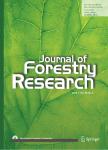Distribution changes of woody plants in Western Iran as monitored by remote sensing and geographical information system:a case study of Zagros forest
Distribution changes of woody plants in Western Iran as monitored by remote sensing and geographical information system:a case study of Zagros forest作者机构:State University of Land Use PlanningMoscowRussianFederation St.Petersburg State UniversityPetersburgRussianFederation Faculty of Natural ResourceUniversity of TehranKarajIran Isfahan University of TechnologyIsfahanIran Faculty of Water and SoilZabol UniversityZabolIran
出 版 物:《Journal of Forestry Research》 (林业研究(英文版))
年 卷 期:2017年第28卷第1期
页 面:145-153页
核心收录:
学科分类:09[农学] 0903[农学-农业资源与环境]
主 题:Monitoring Woody plants Vegetation index RS GIS Zagros forest Iran
摘 要:The status of woody plants in dry-land systems is a fundamental determinant of key ecosystem processes. Monitoring of this status plays an important role in understanding the dynamics of woody plants in arid and semi-arid ecosystems. The present study determined the dynamism of the Zagros forests in Iran using Remote Sensing and Geographic Information System techniques and statistical science. The results show that the density of trees varied from 10 to 53 % according to the physio- graphic and climatic conditions of semi-arid regions. The best and lowest correlation between vegetation indices and forest density were obtained for the global environmental monitoring index (GEMI; R2 = 0.94) and soil adjust vegetation index (R2 = 0.81), respectively. GEMI is used to monitor land use changes over a 10-year period. Results show that 2720 ha2 of forest have been destroyed by human interference and tillage on steep slopes during this period which also resulted in the loss of the fertile soil layer. GEMI determined the areas with a biomass of trees and could normally separate border regions with low bio- mass density of trees from regions without canopy cover. The results revealed that assessment of forest and vegetation cover in arid and semi-arid arduous forest regions using satellite digital numbers and ordinary sampling is subject to uncertainty. A stratified grouping procedure should be established to increase the accuracy of assessment.



